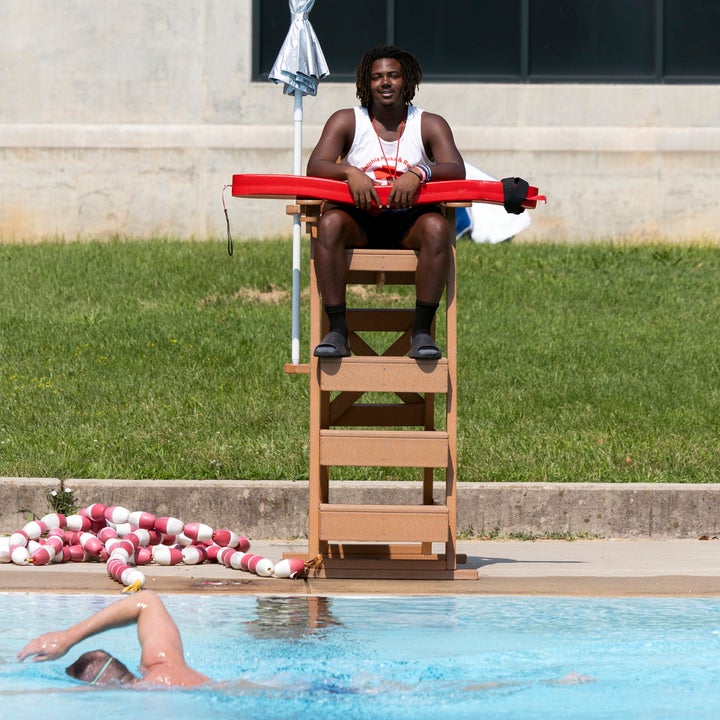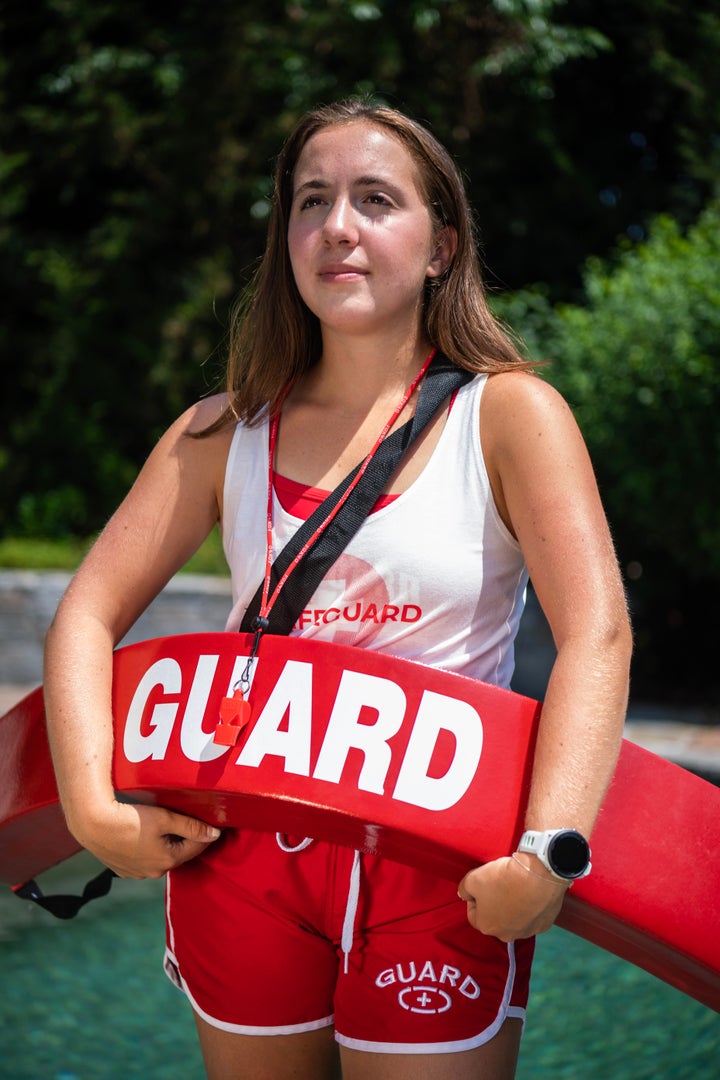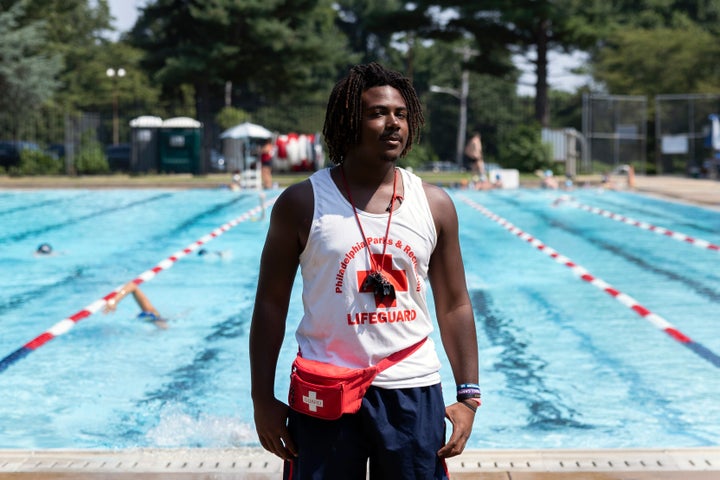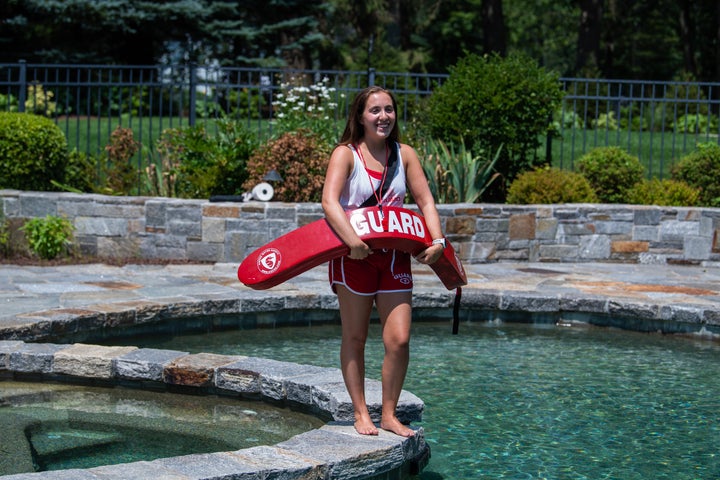These lifeguards have seen it all — and they want you to be safe in the water.
When Daria Maya was 9 years old, she witnessed a lifeguard jump into the pool and save a child from drowning at her birthday pool party. It was an event that helped inspired Maya to seek her own lifeguard certification at age 15. Maya, now 20, has been lifeguarding ever since.
“Although it’s a very responsibility-heavy job, I would say it’s one of the most rewarding things I have done, knowing that you’re protecting people in the water,” said Maya, who is working at Longshore Pool and Compo Beach in Westport, Connecticut, this summer. She created WeLifeguard, a nonprofit service for finding and hiring certified lifeguards in Connecticut and New York for events.
Lifeguarding can be a physically and mentally demanding job for young people. It requires knowing how to swim well and stay calm in emergencies ― and it’s a job that you can start as a teenager.
Kristopher Jenerette, 18, is a lifeguard for the John B. Kelly public pool in Philadelphia. In the three summers he’s been a Philadelphia lifeguard, he’s needed to rescue about 10 people in the pool.
“There’s a lot of responsibility. Like anybody can start drowning … . So I would say my first year I kind of felt on edge a little bit,” he said. “You may be flustered at first, but as you get used to it, it starts to get more easy.”
HuffPost asked Maya and Jenerette to share the biggest misunderstandings about what lifeguards do and what they won’t do at beaches or pools after working as a lifeguard ― and hope that you don’t do either.
I wouldn’t ignore a lifeguard’s whistle.
Ideally, a lifeguard does not ever need to do a dramatic rescue in the water.
“Although it may seem cool in movies, like, ‘Oh, the ‘Baywatch’ lifeguard who goes and saves someone,’ you actually never want to be in a position where you have to save someone. You want to do as many things as possible to prevent something from happening,” Maya said.
Part of that means listening when a lifeguard is blowing the whistle at you to get your attention in the pool or at the beach.
“When I do blow the whistle, I’m usually talking to a specific person. I usually point them out,” Jenerette said. “So I think everybody should focus their attention. It could be something very serious.”
What the whistles mean can vary depending on where you are, but in general they’re asking for your immediate attention.
“We might blow our whistle and we might say ‘Get out of the water’ because we heard thunder or lightning and being in the water during those times is extremely dangerous,” Maya said. “If someone’s drowning, we will tell everyone to get out of the water … . It’s important that you’re paying attention to the lifeguard when you hear those whistles so you know what to do.”

I wouldn’t assume that the lifeguard stopping me from doing what I want is being mean.
Jenerette said it would be helpful for pool visitors to understand that lifeguards enforcing rules are not being mean.
“Sometimes people get, like, hostile. Like, ‘Why does my kid have to do this?’ It’s better if parents understand where it’s coming from,” Jenerette said. “We’re just trying to be here for everybody’s safety. Making sure that everybody has a good time at the pool.”
I would tell the lifeguard I’m a new swimmer.
Instead of seeing lifeguards as only an enforcer of rules, see them as a resource you can go to for assistance.
“Most important things that people don’t really understand that they can do is that you can always introduce yourself to the lifeguard,” Maya said. “So if you’re a new swimmer, this will help the lifeguard pay extra attention to you when you’re swimming … we’re able to know who you are and know your swimming ability, and that helps us make sure, obviously, nothing happens.“
I wouldn’t swim alone.
Maya noted that even when there are lifeguards, she always wants the parents to be watching children, too. Just in general, it’s a good idea to always have someone in your party looking out.
“Always swim with a buddy and never swim alone. That way, if something happens, there’s always someone with you. And there’s always an extra set of eyes,” she said.
Preventing drownings is everyone’s responsibility. That’s why the Water Safety USA organization recommends assigning a person in your group to be a watcher of everyone in or near water every time there is a pool gathering or beach outing, even when a lifeguard is present.
If you’re at a beach, try swimming directly in front of where the lifeguard is posted. “That’s like a straight shot for the lifeguard. They know where you are. They can see you; you can see the lifeguard,” Maya said. “So if anything happens, we’re on it.”

I would not plunge into deeper waters than my limits.
Jenerette advised knowing how deep you can go into the pool before you take a plunge, “because some people try to who are not strong swimmers,” he said.
Maya said a lot of times people do not realize the difference between a shallow and deep end of a pool, but there can be a simple way to find out.
“There will be markers on almost every pool you go to or you can just look down and see the depths of the shallow versus the deep end,” she said. Beginner swimmers should stick to the shallow end, and if you’re not sure which side that is, ask a lifeguard, Maya said.
As for beaches, stick to the areas being lifeguarded. “A lot of times we see people who swim too far out,” Maya said. “It takes a lot of energy to swim out, and they forget about the currents and the riptides that make it a lot harder to swim back in than it is to swim out. And I think that’s one of the biggest problems we see at the beach.”

I wouldn’t let a kid swim without lessons.
Drowning is the leading cause of death for children ages 1 to 4 and the second-leading cause of unintentional death in children ages 5 to 14, according to the Centers for Disease Control and Prevention. That’s why learning how to swim can be so important.
“That’s the best, most helpful thing for a lifeguard, is putting your kids in swimming lessons so they’re able to swim,” Maya said. “That helps us a lot because we’re less worried that anything’s possibly going to happen.”
I wouldn’t jump into the water without looking to see who’s already there.
Plunging into the pool can be refreshing, but when you’re not checking to see where you are landing, accidents are more likely to happen.
“Most common things we see is people not looking and they just jump, and they jump one on top of each other. So that’s obviously not good,” Maya said.

I would encourage teens to become lifeguards.
Lifeguarding can involve rigorous training and big responsibilities. In the city of Philadelphia, for example, where Jenerette works, his lifeguard screening involved 12 nonstop laps of swimming in a 25-yard pool, treading water for two minutes without using arms and physically retrieving a 10-pound brick.
“I had to rescue it from the bottom of the pool and bring it back,” he said. And that’s on top of online training. “There’s a lot of stuff you have to remember for when you actually do the training in person,” Jenerette said.
But it can also be a lot of fun.
“I do like getting in the pool on my breaks,” Jenerette said. “Other than that, I like interacting with different types of people at the pool. A lot of people like to have conversations with the lifeguard, which is one of my favorite parts about the job.“
Maya said when she was younger she had all the swimming skills needed to do the job well, but she was nervous about the lifesaving responsibility.
But what she would want her younger self and any aspiring lifeguard to know is that there’s no reason to be nervous. “All your other guards are there to help you. And there’s a lot of support surrounding being a lifeguard … . If you want to become a lifeguard, go for it. Most people, as long as you have the ability to swim, you’re probably able to become a lifeguard.”
Credit: Source link